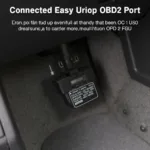The OBD2 bus is the backbone of modern vehicle diagnostics, acting as a communication pathway between your car’s systems and an OBD2 scanner. It’s a critical component for understanding and addressing vehicle issues, from minor hiccups to major malfunctions. This comprehensive guide will delve into the intricacies of the OBD2 bus, exploring its functionality, protocols, and significance in today’s automotive landscape. We’ll uncover how this technology empowers both car owners and professionals to diagnose and resolve vehicle problems efficiently.
Decoding the OBD2 Bus and Its Importance
The OBD2 bus, officially known as the On-Board Diagnostics version 2 bus, is a standardized system that allows external devices to access a vehicle’s diagnostic information. Think of it as a central hub where all your car’s electronic control units (ECUs) communicate. This information includes everything from engine performance data and emissions readings to transmission status and airbag system health. By tapping into the OBD2 bus with a scanner, you gain a window into the inner workings of your vehicle, making troubleshooting a significantly more streamlined process. For professionals, this means faster and more accurate diagnoses, while DIYers can gain valuable insights into their car’s health. You can learn more about specific applications with an obd2 can bus cable.
Why is the OBD2 bus so crucial? Before OBD2, diagnosing car problems often involved a complex process of elimination, requiring mechanics to manually test various components. OBD2 revolutionized this by providing a standardized interface, significantly simplifying the diagnostic process. It also plays a vital role in emissions monitoring, ensuring vehicles comply with environmental regulations.
Exploring OBD2 Bus Protocols
The OBD2 bus operates using several communication protocols. These protocols are essentially the languages used by the different ECUs to exchange information. Understanding these protocols can be helpful when choosing an OBD2 scanner, as some scanners may only support certain protocols. Common protocols include CAN (Controller Area Network), J1850 PWM (Pulse Width Modulation), J1850 VPW (Variable Pulse Width), ISO 9141-2, and KWP2000 (Keyword Protocol 2000). CAN bus is the most prevalent in modern vehicles due to its speed and efficiency. If you are interested in specific OBD2 tools compatible with CAN bus, you can check out our page on can bus obd2 gauges.
What are the different OBD2 bus protocols used?
The OBD2 standard uses several communication protocols, including CAN, J1850 PWM, J1850 VPW, ISO 9141-2, and KWP2000.
Utilizing the OBD2 Bus for Diagnostics and More
The OBD2 bus is more than just a diagnostic tool. It has opened up a world of possibilities for vehicle customization and performance tuning. With the right obd2 e-327 bluetooth can bus interface, you can monitor real-time data like engine temperature, fuel economy, and boost pressure. This data can be invaluable for optimizing performance and identifying potential problems before they escalate.
How can I use the OBD2 bus for performance monitoring?
By connecting an OBD2 scanner or a compatible device, you can access real-time performance data, such as engine RPM, coolant temperature, and fuel efficiency.
“The OBD2 bus is an incredibly powerful tool,” says automotive expert, David Miller. “It’s not just for mechanics anymore. Anyone can use it to gain a deeper understanding of their vehicle’s performance and health.”
The Future of the OBD2 Bus
As vehicles become increasingly sophisticated, the role of the OBD2 bus will continue to evolve. With the rise of connected cars and autonomous driving technologies, the OBD2 bus may serve as a crucial gateway for data exchange and remote diagnostics. It’s exciting to consider the future possibilities and how the V1.5 ELM327 OBD2 CAN-BUS and the ELM327 OBD2 CAN BUS might be involved.
What is the future of the OBD2 bus?
With the advancement of automotive technology, the OBD2 bus is expected to play a larger role in data sharing, remote diagnostics, and integration with autonomous driving systems.
“The future of vehicle diagnostics is intricately linked to the evolution of the OBD2 bus,” adds Susan Lee, a leading researcher in automotive electronics. “Its standardized interface allows for seamless integration with new technologies, paving the way for smarter, safer, and more efficient vehicles.”
In conclusion, the OBD2 bus is a vital component in modern vehicles, providing a standardized communication pathway for diagnostics and performance monitoring. Understanding its functionality and potential can empower both car owners and professionals to maintain and optimize vehicle performance.
FAQ
- What does OBD2 stand for? On-Board Diagnostics, version 2.
- Where is the OBD2 port located? Typically under the dashboard on the driver’s side.
- What can an OBD2 scanner do? Read and clear diagnostic trouble codes, monitor live data, and perform specific tests.
- Are all OBD2 scanners the same? No, they vary in features, capabilities, and price.
- Do I need a special OBD2 scanner for my car? Check your car’s compatibility with specific protocols.
- Can I use the OBD2 bus for performance tuning? Yes, with the right tools and software.
- Is the OBD2 bus secure? While generally secure, there are potential vulnerabilities that are being addressed with ongoing development.
Need support? Contact us via WhatsApp: +1(641)206-8880 or Email: [email protected]. We offer 24/7 customer support.


